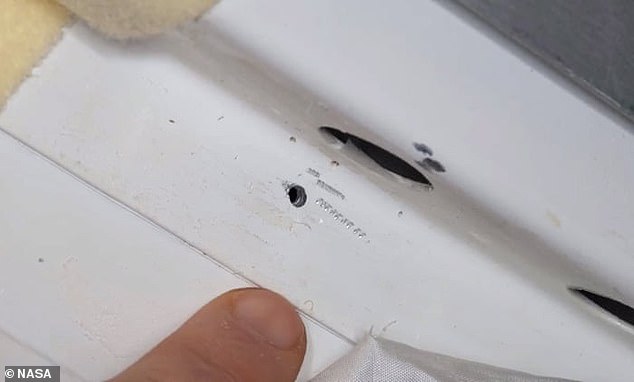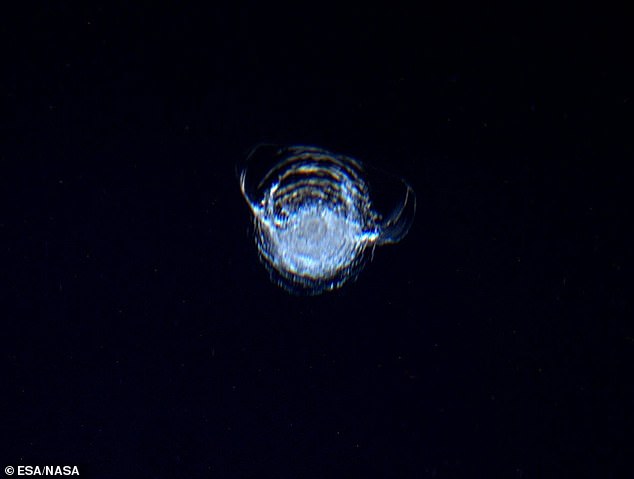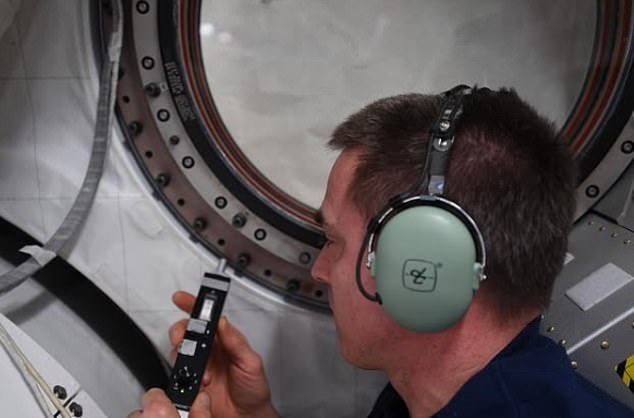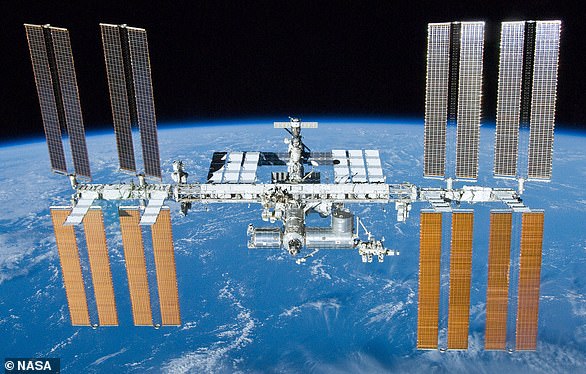Shocking photos show how NASA’s decaying ISS has been leaking and cracking for years amid evacuation fears
From holes in the robot arm to cracks in the window: astronauts have been complaining about the condition of the International Space Station (ISS) for years.
A NASA report this week admitted there are 50 “areas of concern” and four cracks that could lead to an emergency evacuation from the ISS due to oxygen leakage.
NASA warned that the problems stemmed from a single leak that reached its fastest growth yet in April this year.
If the crew makes the daring escape, it would be the first time in the space laboratory’s 24-year history to house astronauts.
The first problems were reported in 2013, when a piece of space debris caused a small hole in one of the outpost’s solar panels.
And three years later, an astronaut discovered a small circular crack in a window looking out into the darkness of space.
Astronauts have said that NASA has done very little to address the increase in leaks aboard the ISS, but in 2021 NASA denied claims that there were ‘bad’ cracks in the module and said there were no problems ‘that affected the crew or normal business operations’.
Dozens of other leaks and cracks have now developed, which have only been repaired with special tape, mesh and sealant.
The current problem is in Russia’s Zvezda Service Module Transfer Tunnel, which was installed in 2000 and is used to house life support equipment and access a Russian cargo dock.
In 2019, the module started leaking a small amount of air through an unknown crack. Despite efforts to seal the module, the amount of air escaping from the station has only increased over the past five years.
The Canadarm2 robotic arm was struck by space debris in May 2021, creating a hole that fortunately did not affect the functionality of the robotic arm

It is not the first time that the ISS has leaked. In 2018, astronauts rushed to repair a hole (pictured) that had appeared in the outer wall of the Soyuz capsule in the orbiting laboratory.
Russia previously predicted that the space station would face a “cascade of failures” from 2025 due to its age.
The ISS became fully operational in May 2009, when it carried six crew members, but the orbiting laboratory was not continuously staffed until November 2, 2000.
For over a decade, the ship has been bombarded by small meteors and space debris crumbling on the outside.
The exact cause of the growing air leak is unknown, but NASA and Roscosmos are focusing on internal and external welds as a possible source.
Many of the internal problems stem from the Russian side of the ISS.
In December 2022, unexpected damage occurred to the Soyuz spacecraft attached to the ISS, causing coolant leaks and making the vehicle unsafe for the return flight.
The year before, Bill Shepherd, who was a NASA astronaut from October 2000 to March 2001, said the cracks found on the ISS were a “fairly serious problem” and claimed there could be others that had not yet been found.
The crack was discovered in Russia’s Zarya module.
Shepherd said the cracks needed to be fixed before Congress authorized the ISS for operational use after 2024.
ISS contractor Vladimir Solovyov said at the time that a number of “superficial fissures” had been found on Zarya.
This module is also known as the ‘Functional Cargo Block’ and Solovyov said the cracks were exposed in a ‘number of places’.
“This is bad and suggests that the rifts will spread over time,” Soloviev told Russia’s state news agency RIA.
He added that a significant portion of the equipment on the ISS is aging.

ESA astronaut Tim Peake took this photo from inside Cupola in 2016, showing a circular chip with a diameter of 7 mm ripped out by the impact of a small piece of space debris
NASA had vehemently denied claims that there were “severe” cracks in the module, saying there were no issues “impacting the crew or normal operations.”
In 2016, a piece of paint floating in space collided with a window on the ISS, creating a seven-millimeter chip in the station’s Cupola.
‘I am often asked whether the International Space Station is hit by space debris. Yes, this is the chip in one of our Cupola windows, I’m glad it has quadruple glazing,” said European Space Agency (ESA) astronaut Tim Peak, who was on the ISS.
To accommodate such possibilities, the station is equipped with extensive shielding around all vital crew and engineering areas so that minor attacks such as this do not pose a threat.
Then in 2018, a hole caused an oxygen leak in the ISS, which the Russian space agency Roskosmos claimed was deliberately caused.
They initially thought the damage was caused by a micrometeorite that had punctured the spacecraft, but an anonymous source claimed the hole had been accidentally drilled by a worker who sealed it off instead of reporting the mistake.

The space organizations have been monitoring the current leak for years. The photo now shows former NASA astronaut Chris Cassidy trying to find the source of the leak in 2020. Astronauts isolated in the Russian part of the ship
The small hole was found and quickly closed, but Russian media speculated that an American astronaut may have sabotaged the spacecraft to delay a possible early return to Earth due to the alleged illness of an ISS crew member.
However, an investigation into the incident has not revealed what the cause of the hole was.
The Canadarm2 robotic arm, which properly maintains the space station on the ISS, was struck by space debris in May 2021.
Fortunately, the hole did not cause any major disruptions.
The Canada Space Agency, which owns the robotic arm, said at the time: “The results of the ongoing analysis indicate that the arm’s performance remains unaffected. The damage is limited to a small part of the arm boom and the thermal blanket.’
In 2023, one of the Nauka Multipurpose Laboratory Module radiators experienced a coolant leak and the crew was asked to close the windows of the US segment to avoid contaminating the rest of the ISS.
The leak forced all spacewalks to be postponed while the backup radiator was isolated and inspected.
The latest problem was first reported last month, despite officials having known about the Zveda crack since 2019 and although the potential cracks have been covered with ‘a combination of sealant and band-aids’, the exact source of the leak is unknown.
Astronauts have been warned to remain in the US section when the module is open so they can be close to their spacecraft in the event of an emergency evacuation, and they have been warned not to open the hatch unless absolutely necessary.
And that’s not the only cause for concern, as the space agency has warned that the ISS is at risk of being pelted with micrometeors and space debris.
An object up to one centimeter in size can disable an instrument or a crucial flight system on a satellite.
Anything larger than one centimeter can penetrate the shields of the station’s crew modules, and anything larger than four inches can break a satellite or spacecraft into pieces.
It is estimated that more than 29,000 pieces of space debris larger than 10 centimeters are currently in Earth’s orbit.
This includes old engine parts, dead satellites, and other floating debris generated by space missions or from space collisions.

